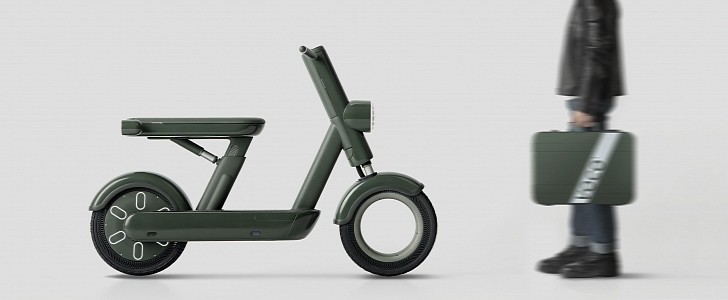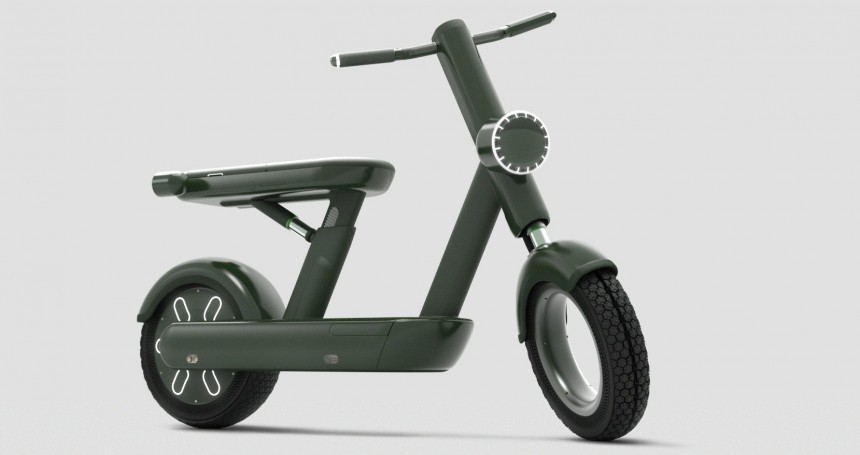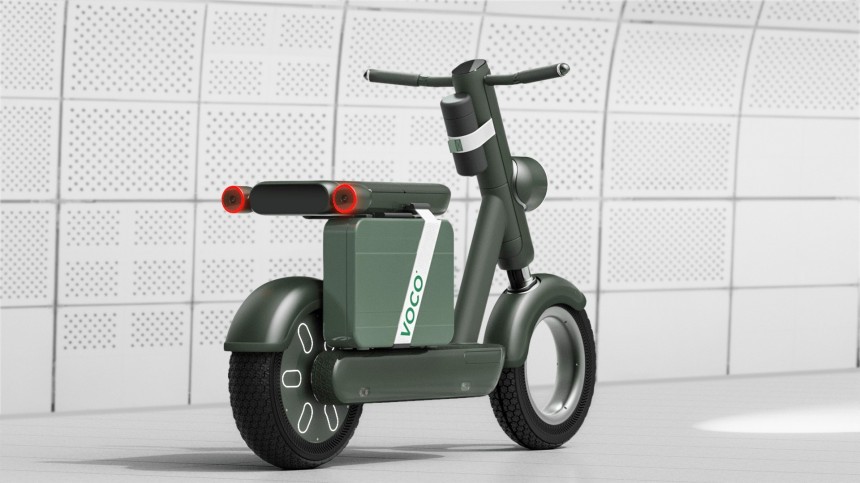Current technological movements are leaning towards a future where vehicles can drive independently. While this is explorable in stable three and four-wheeled vehicles, two-wheelers are a whole different story.
Nonetheless, some designers are still exploring the possibility of adapting autonomous systems to a two-wheeled vehicle. Two such designers are Kim Hye-won and Kwangseuk Go of South Korea, you know, the cool, calm, and collected Korea.
These two industrial designers in training have explored and eventually designed a two-wheeled vehicle dubbed Voco. Whatever that stands for, we have no idea, and neither does Google Translate. Nonetheless, the ideas explored in making a two-wheeled trinket apply autonomous control to its function appear valid.
Overall, Voco looks very similar to modern-day mopeds, but, as if in Korean fashion, it does come in with a sleek and minimalist design. If you study concepts and renderings, Korean designers and artists are all about the maximum capability for minimal material. To get a clear understanding of what we're presented, I'll start with the overall design and work my way to the more specific tricks.
Voco is driven by a rear hub motor powered by a battery pack mounted in the footboard. On the other hand, the front wheel is hubless, something we're seeing more and more of in modern machines. Two shocks, one above the front wheel and one under the seat, are found for suspension.
One attractive feature of the seating is that it's adjustable, putting this vehicle into as many hands as possible. Then there's the seat's ability to store a device or two underneath the cushion. Speaking of storage, the footboard of Voco extends outward a bit near the rear, allowing you to secure luggage or other goods.
As for the autonomous ability that this concept displays, some I've seen before. By this, I'm referring to the inclusion of LiDAR sensors built into the headlight of Voco. An outer ring of LEDs lights your roadway, while the center features sensors to make sure objects are identified and avoided safely.
However, for a two-wheeled machine, LiDAR and Radar are not enough to make sure these vehicles can maneuver around town; there's a question of balance. The main obstacle in making an autonomous two-wheeler is that there's no way to balance it. Well, there is, but it takes quite a bit of engineering and money to do so.
So to create a vehicle able to stand on its own and move as well, the two bright minds chose to focus their attention on the wheels. If you look closely at the wheels, one of the first things you'll notice is a latticework of rubber. Aside from providing what looks like excellent gripping capabilities, these tires can inflate and deflate on command to help Voco stay upright. Wait a minute, what!? Yeah.
It's relatively simple, really. For Voco to remain upright, it deflates its tires to create a flat surface, much like the surface produced by a car's tire when in contact with the road. This offers increased lateral support as the wheel is no longer balanced on one pivot point but has a large lateral strip of contact for stability. Now, that's one ingenious shortcut.
How would this fare in real-world applications? Theoretically, this should work, but testing is definitely needed to see how stable a vehicle can be with such a design and at what speeds.
Even though Voco is nothing more than a concept, it still presents the world with one possible solution to a problem that some manufacturers are facing for sure. After all, how cool would it be to sit back and read autoevolution articles on a motorcycle in motion? I thought so.
These two industrial designers in training have explored and eventually designed a two-wheeled vehicle dubbed Voco. Whatever that stands for, we have no idea, and neither does Google Translate. Nonetheless, the ideas explored in making a two-wheeled trinket apply autonomous control to its function appear valid.
Overall, Voco looks very similar to modern-day mopeds, but, as if in Korean fashion, it does come in with a sleek and minimalist design. If you study concepts and renderings, Korean designers and artists are all about the maximum capability for minimal material. To get a clear understanding of what we're presented, I'll start with the overall design and work my way to the more specific tricks.
Voco is driven by a rear hub motor powered by a battery pack mounted in the footboard. On the other hand, the front wheel is hubless, something we're seeing more and more of in modern machines. Two shocks, one above the front wheel and one under the seat, are found for suspension.
As for the autonomous ability that this concept displays, some I've seen before. By this, I'm referring to the inclusion of LiDAR sensors built into the headlight of Voco. An outer ring of LEDs lights your roadway, while the center features sensors to make sure objects are identified and avoided safely.
However, for a two-wheeled machine, LiDAR and Radar are not enough to make sure these vehicles can maneuver around town; there's a question of balance. The main obstacle in making an autonomous two-wheeler is that there's no way to balance it. Well, there is, but it takes quite a bit of engineering and money to do so.
So to create a vehicle able to stand on its own and move as well, the two bright minds chose to focus their attention on the wheels. If you look closely at the wheels, one of the first things you'll notice is a latticework of rubber. Aside from providing what looks like excellent gripping capabilities, these tires can inflate and deflate on command to help Voco stay upright. Wait a minute, what!? Yeah.
How would this fare in real-world applications? Theoretically, this should work, but testing is definitely needed to see how stable a vehicle can be with such a design and at what speeds.
Even though Voco is nothing more than a concept, it still presents the world with one possible solution to a problem that some manufacturers are facing for sure. After all, how cool would it be to sit back and read autoevolution articles on a motorcycle in motion? I thought so.











